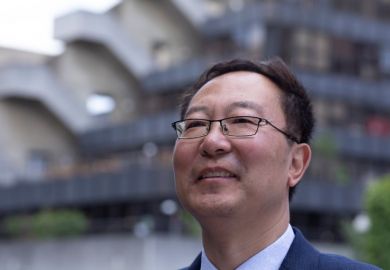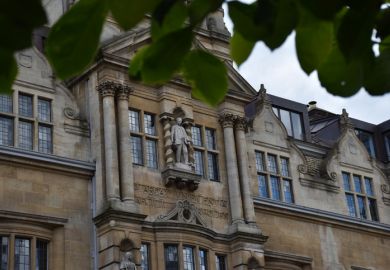Amid the loud and entirely understandable calls to decolonise the curriculum, the domination of “Western” knowledge itself has sometimes come under attack.
For instance, in a recent article in University World News, Simon Marginson, professor of higher education at the University of Oxford, complained about “Anglo-American globalisation” and “its enforced uniformity of cultures and languages, the stigmatisation and exclusion of everything different”.
“All endogenous (indigenous) knowledge is excluded,” he wrote. “The closure is sustained by that deep Anglo-American certainty that ‘our’ culture is not only best, but sufficient and no other insight is needed.”
But Western conceptions of knowledge underlie the idea of the Western university – and it is striking how comprehensively that idea has been adopted around the world.
“Western model” universities were established in the Global South mainly in the 19th century. Colonialism was, of course, the key driver. Christian missionary efforts also played an important role – and often the two were linked.
The colonisers had different approaches to higher education. The British were active in permitting or sponsoring it, the French less so, while the Portuguese eschewed academic development entirely. The Spanish “outsourced” higher education to the Catholic Church, particularly the Jesuits, with the dual goals of Christian conversions and colonial management. All recognised the need for a small Western-educated indigenous class to manage the colonies.
In India, the modest expansion of higher education under colonialism was largely a result of missionary efforts and Indian initiatives to provide access to the civil service and burgeoning commerce for an emerging middle class. The British authorities made few investments in higher education until 1857, only then trying to control this nascent sector.
Unsurprisingly, the institutions that emerged followed the British model and used English as the medium of instruction. It is, of course, significant that all colonial universities used the language of the coloniser – and lots of former colonies still do.
Many global regions had rich intellectual, religious and educational traditions before the advent of colonialism. Universities were first established in South Asia – Taxila and Nalanda. Al-Qarawiyyin University in Fes and Al-Azhar University in Cairo also predated the first European universities – and both still exist today. But while the intellectual and religious traditions continued in South Asia and the Arab world, the traditional academic institutions could not successfully compete and were gradually eclipsed by Western-model alternatives.
Colonial universities used the languages of the colonists since their primary purpose was to train people to staff colonial governments. Similarly, the curriculum was entirely imported from the metropole. It is only a slight oversimplification to summarise colonial attitudes toward indigenous cultures with the words of British administrator Thomas Babbington Macaulay: “a single shelf of a good European library was worth the whole native literature of India and Arabia”.
Interestingly, though, in the post-colonial era, no country has returned to a pre-colonial higher education model. Moreover, it is not only colonised nations that adopted the Western higher education model. For instance, after the Meiji restoration in 1868, Japan searched for a university model that would serve a modernising society and, after careful examination of the options, adopted German and American approaches, ignoring centuries-old indigenous traditions.
Similarly, when Thailand looked to modernise its higher education and society, in part to hold off possible colonial incursions, Western models were chosen, culminating in the establishment of Chulalongkorn University in 1917. In no case did non-colonised countries seeking to modernise higher education adopt an indigenous, traditional model.
The Chinese experience is significant as well. In an article, “World Class Universities in China’s Heroic Past”, recently published in International Higher Education, Yang Rui points out that a variety of Western Christian missionary institutions, as well as the Chinese government’s own use of Western models in the late 19th and early 20th centuries, were influential in developing modern higher education in China – and proved successful. Significantly, the powerful, traditional Confucian model of education was not used to guide China’s modernisation, except perhaps for the traditional civil service examination that evolved into the present-day gaokao.
When countries in the Global South became independent, they maintained and expanded the Western university model, perceived as an essential instrument for nation-building and human capital development. Notwithstanding a large variety of economic systems, political realities, stages of socio-economic development and religious and cultural traditions, almost every university in the 21st century follows a broadly Western model.
A lot can certainly be done to make such institutions more inclusive, sustainable and socially responsible. A growing number have started to re-examine their past with a critical eye, acknowledging their close association with ugly moments in their country’s history, such as slavery, apartheid or discrimination against native population groups. They have begun making their programmes more attuned to the experience of traditionally oppressed and marginalised social groups.
At the same time, it is essential to safeguard the fundamental values of the Western university model, dedicated to the search for truth based on scientific evidence and academic freedom. The mathematician and philosopher Alfred North Whitehead memorably depicted the role of universities as welding together imagination and experience. In a world full of grand challenges, that task has never been more vital.
Philip G. Altbach is research professor and distinguished fellow, Center for International Higher Education, Boston College, US. Jamil Salmi is a higher education expert, emeritus professor of higher education policy at Diego Portales University, Chile, and former tertiary education coordinator at the World Bank.
Register to continue
Why register?
- Registration is free and only takes a moment
- Once registered, you can read 3 articles a month
- Sign up for our newsletter
Subscribe
Or subscribe for unlimited access to:
- Unlimited access to news, views, insights & reviews
- Digital editions
- Digital access to THE’s university and college rankings analysis
Already registered or a current subscriber?








